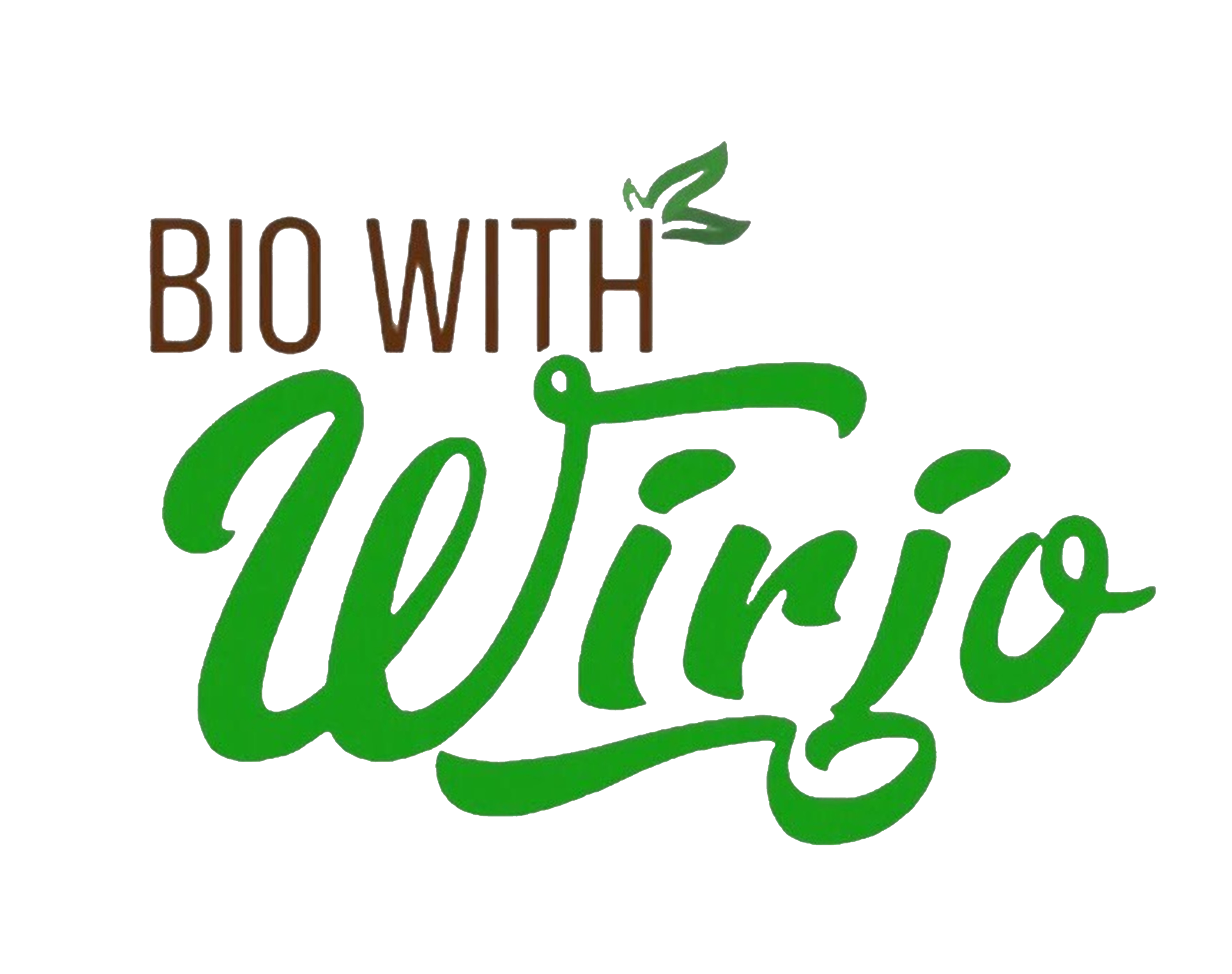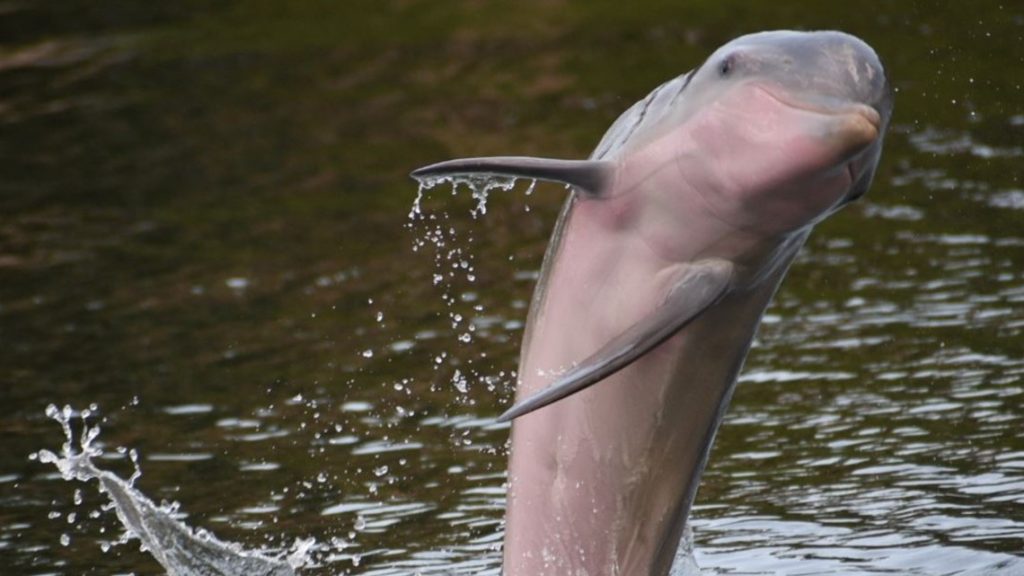Dolphins are mammals. They are warm-blooded, they give birth to a life young and suckle it. In contrast to other mammals they do not have hairs on their body. Dolphins spend their whole life in water. They breathe through a blowhole, a muscled nostril on top of their heads. For this reason they regularly surface. Dolphins can produce high to very high (inaudible for
humans) sounds. On the basis of the re-echoed sound they can orient themselves and find prey (echolocation). aarnemen (echolocatie). Dolphins have a streamlined body like fish that allows them to move quickly through the water. If they do not eat or rest, they often jump over each other and make all kinds of leaps above water.
Along the coast of Suriname occurs one dolphin species, the estuarine or Guiana Dolphin (or profosu, as this small elegant dolphin is called in Suriname). It occurs to the North of Suriname up till Nicaragua (14º NB), to the south up till South Brazil (27º ZB). Profosu live in shallow parts of the sea and in the estuaries of large rivers. Upstream we can encounter them up to
where the water is still brackish. In the Suriname River profosu could be seen in the past up to Domburg and Paranam. Currently, they do no go that far in; with high tide they can still be seen up to the Waterkant. River pollution could be a
reason why they no longer swim so far upriver. In the Commewijne River they are sometimes still seen up to Bakkie in the long dry season.
Naming
In 1864 the profosu was first described by P.J. van Bénéden, who gave the dolphin the scientific name Delphinus guianensis. Later the profosu was included in the Sotalia family, first as a subspecies of the river dolphin Sotalia fluviatilis from the Amazon, but since 2007 as a full species: Sotalia guianensis. Researchers and institutes in South America, including the
Green Heritage Fund Suriname, proposed to call this dolphin from now on: Guianadolfijn in Dutch and Guiana Dolphin in English. The profosu belongs to the toothed whales. It is a small grey dolphin that has commonly a pink and sometimes a white belly. These dolphins can become over 2 meters long. At birth they are approximately 90 cm long
Notable Facts | |
Population Size Suriname River | 100-125 animals |
Length of adult animals | 180-210 cm |
Dorsal | colour light greyish blue to dark grey |
Ventral | colour pink to light pink and white |
Dorsal fin | 11-13 cm high |
Teeth | 30-35 in each jaw |
Food | fish, shrimp, cephalopods (sometimes) |
Breathing every | 80 seconds |
Group size | a few to several dozens |
Observable Behavior
Due to the turbid waters along the Surinamese coast it is difficult to observe the behavior of this dolphin under water. From a boat we can only see something of their behavior when the animals surface.
Foraging and Feeding
The food of the profosu consists mainly of fish and shrimp. The animals are masters in catching these. Sometimes you can see how the animals throw a fish in the air and then eat it. When feeding we often see that they put their tails right up in the air, which is called a tail flip. When observing the typical behavior of dolphins foraging remain at a distance, and admire their speed, strength and agility. After all, we would not enjoy if someone came speeding straight through our picknick.
Playing and Socializing
When dolphins play we can see them leaping out of the water, breaching and lunging, sometimes five times in a row. They can also jump sideways and backways, showing their beautiful pink belly. When they are in such a playful mood,
they often enjoy coming close to the boat and observing the people in the boat. They will bowride, swim around the boat and keep their heads out of the water for a prolonged time, also called spy-hopping. When they display this behaviour
they are often in large groups together. When observing this behavior, the boat is brought to a stop and the motor is shut down; and we leave it up to the dolphins how they communicate with the human guests.
Resting and Sleeping
Dolphins rest and sleep on average eight hours per day. As they have to surface each time to breath (dolphins breath consciously, humans breath automatically), they sleep only with one brain half at a time. By alternating the sleeping
brain half all the time, they can sleep and breath on the water surface. When they rest, they often swim slowly abreast in large formations. When we see that the dolphins are resting, the motor is shut down or is idling and the dolphins are observed from a distance and are given the room to pass the boat.
Learning and Caring
The gestation period of a profosu is 12 months. Dolphin babies remain always close to their mother, because they continue breast-feeding for 18 to 36 months. Young dolphins learn, when they are 5-6 months old, to also eat fish. They learn from the mother and other older animals in the group how they can orient themselves, hunt, and socialize. Swimming with dolphins is not allowed, this disturbs their natural behavior and possible agression from a mother animal can of course never be excluded.
“Travelling”
Sometimes we see dolphins passing by. They will slightly bring their head above the water to see what their position is in the water, where they are headed and to see where the sound is coming from produced by the motor.
Protection and Threats
Profosu are in protected in Suriname on the basis of the Game Act around the year. This does not mean there are not threats. They can become entangled in fishing nets, run into boats or be disturbed by the vibrations of the motors of the boats. Tourists can also have a detrimental effect on the dolphins if they do not observe the guidelines for responsble dolphin
tourism (see guidelines below). Further pollution of the Suriname River would in the long run have a negative influence on the animals in the estuary. The same applies to the dredging of the canal for shipping in this river and the dumping
of the sludge material in sea (possible influence on the local fish stock).
Dolphin Research in Suriname
A group of volunteers, falling under a programme of the Green Heritage Fund Suriname, has been collecting data on a regular basis on the population and behavior of dolphins in the Suriname River estuary since 2005. This programme is the first research of wild dolphins in Suriname. The goal of this research programme is to protect the dolphin population in the estuary of this river. As a result the group is closely involved in looking at the effects of the dredging of the canal on the
dolphins. The group also engages in promoting responsible and sustainable dolphin tourism in consultation with the local community, and in providing information about the dolphins and the protection of their habitat.
Research Site
The research site of the dolphin programme in the Suriname River includes the area between Leonsberg and Braamspunt, where many dolphins are seen. This area is an open river mouth with along the river banks mud flats that are exposed during low tide. Mangroves line the shores along the river. River mouths are known as areas rich in food. There is a high fish density and all kinds of invertebrates like crabs and shrimps occur in abundance. The food richness in the water and on the mudflats
also forms a good feeding ground for large numbers of shore birds, including the brightly colored scarlet ibis (which can be seen flying over the area in flights of over 100 birds) and the brown pelican.

